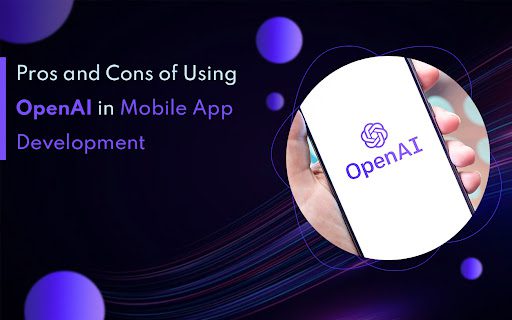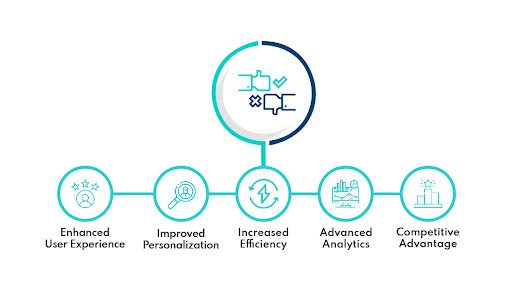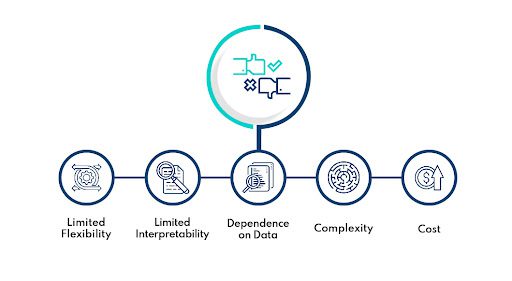
From chatbots to IoT devices to predictive analytics, organizations today are exploring innovative approaches to implement artificial intelligence to revolutionize the mobile app development business.
Artificial intelligence is growing drastically in the tech sector and assisting innovatively with various tasks such as creating images and generating content. However, it cannot do everything.
This article is all about understanding what actually Open AI is, the pros and cons of OpenAI, and the latest statistics.
Latest Statistics Of OpenAI
- The firm’s revenue is expected to reach $200 million by the end of 2023, while it is likely to increase to $1 billion by 2024.
- The official site of OpenAI ranks, 1441st in the list of most popular sites worldwide.
- Around 43.63% of the website traffic comes from searches, while 48.98% comes from direct links.
- Microsoft Corp. to invest $10 billion in OpenAI.
What is Open AI?
OpenAI is an artificial intelligence (AI) research laboratory consisting of highly skilled researchers, engineers, and scientists dedicated to creating and advancing AI safely and beneficially.
It aims to create a world where AI technologies are developed in a way that is the safe, ethical, and transparent way. OpenAI is working to address these challenges by developing advanced AI technologies, including natural language processing, computer vision, and robotics. They also research reinforcement learning, deep learning, and generative models.
OpenAI has developed several innovative AI models, including GPT-3, DALL-E, and CLIP, which have been used in many applications, from chatbots and virtual assistants to image recognition and content creation. OpenAI has also partnered with several leading organizations, including Microsoft, to advance the development and deployment of AI technologies.
Benefits of Developing an App with OpenAI’s API
Developing an app with OpenAI’s API can provide many benefits to developers and end-users alike. A reputed AI development company can help you develop open AI-based apps to help you grow your business. Here are some general benefits of creating an app with OpenAI’s API:
1. Advanced AI Capabilities
AI provides developers with access to some of the most advanced AI models available today, including GPT-3, DALL-E, and CLIP. These models can automate tasks, enhance user experience, and create personalized content, among other things.
2. Efficiency and Productivity
It can help developers create more efficient and productive apps by automating time-consuming and repetitive tasks. For example, GPT-3 can be used to automate customer support inquiries, while DALL-E can be used to generate visual content quickly and easily.
3. Personalization
The technology allows developers to create personalized user experiences by leveraging AI capabilities such as natural language processing and image recognition. This can improve user engagement and retention and provide a more tailored and customized experience for each user.
4. Scalability
It is designed to be highly scalable, allowing developers to handle large volumes of requests and data easily. This makes it ideal for developing apps that handle large numbers of users or process large amounts of data.
5. Collaboration
OpenAI’s API is designed to be open and collaborative, allowing developers to share and collaborate on their work with others in the development community. This can foster innovation and accelerate the pace of AI development.
Pros of Open AI
OpenAI is a powerful tool developers can leverage to create better and more sophisticated apps. If you hire app developers you can get more efficient, personalized, and secure apps, providing a better user experience and a competitive advantage in the marketplace. By leveraging the power of OpenAI, developers can stay ahead of the curve and deliver apps that meet the evolving needs of users.

Here are some of the advantages of using OpenAI in app development:
1. Enhanced User Experience
It helps improve user experience by enabling apps to understand better and respond to user input. With its natural language processing and machine learning capabilities, OpenAI can help developers create apps that can understand and interpret user requests, provide intelligent responses, and even predict user needs based on past behavior.
2. Improved Personalization
It helps make apps more personalized and relevant to individual users. By analyzing user data, OpenAI can help apps make better recommendations and tailor their functionality to meet the specific needs of each user.
3. Increased Efficiency
The technology automates many tasks, enabling apps to work more efficiently and effectively. For example, OpenAI can automate customer service inquiries, reducing the workload on support staff and improving response times.
4. Advanced Analytics
It basically analyzes large amounts of data, providing insights that can help developers improve their apps. By analyzing user behavior, OpenAI can help developers identify areas for improvement and make data-driven decisions about new features and functionality.
5. Better Security
It simply detects and prevents security threats, helping protect user data and fraud. By analyzing user behavior, OpenAI can help identify potential threats and take proactive measures to protect against them.
6. Competitive Advantage
By leveraging the power of OpenAI, developers can create more advanced and sophisticated apps than their competitors. This can help apps stand out in a crowded marketplace and attract more users.
Cons of Open AI
OpenAI can bring many benefits to app development, but there are also potential drawbacks, including cost, complexity, dependence on data, limited interpretability, ethical concerns, and limited flexibility. Developers should carefully weigh the benefits and drawbacks of using OpenAI in their apps and ensure they have the resources and expertise necessary to use AI effectively.

Here are some of the cons of using OpenAI in app development:
1. Cost
Developing apps that use OpenAI can be expensive. The cost of training and maintaining AI models can be expensive, particularly for smaller companies or developers who may need more resources to invest in AI.
2. Complexity
Working with OpenAI can be complex and time-consuming, particularly for developers unfamiliar with AI technologies. Developing, training, and testing AI models requires specialized knowledge and skills, which can be a barrier to entry for some developers.
3. Dependence on Data
OpenAI models require large amounts of data to be trained effectively. Suppose there needs to be more data available, or the data needs to be representative of the target user population.
4. Limited Interpretability
OpenAI models can be challenging to interpret, particularly for end-users who may need help understanding the underlying technology. This can be a challenge for developers who need to explain how the app works or why the AI made certain decisions.
5. Limited Flexibility
OpenAI’s models are designed to perform specific tasks and may not be adaptable to new or changing requirements. This can be a limitation for developers who need to update their apps or add new features that require different AI functionality.
3 Important OpenAI Models for App Development
OpenAI offers a variety of powerful models that can be used in app development to improve user experience, enhance functionality, and automate tasks. GPT-3, DALL-E, and CLIP are just a few examples of the many OpenAI models available to developers, and each offers unique benefits and capabilities. By leveraging these models, developers can create more advanced and sophisticated apps that meet the evolving needs of users.
Here are three important OpenAI models that developers can use in app development:
1. GPT-3 (Generative Pre-trained Transformer 3)
GPT-3 is a language processing model that can generate human-like text based on a given prompt. It has been trained on a dataset of text, making it highly versatile and able to generate text on a wide range of topics. GPT-3 can be used in app development to automate tasks such as customer support, develop personalized recommendations, and create content for the app.
2. DALL-E (Dali-GPT: Image to Text)
DALL-E is a unique OpenAI model that can generate images from textual descriptions. This model can be used in app development to create customized visual content for users, such as personalized avatars or custom illustrations. It can also automate the process of creating visual content, saving time and resources for developers.
3. CLIP (Contrastive Language-Image Pre-Training)
CLIP is an image recognition model that has been trained on both images and natural language. This unique training allows CLIP to identify the content of images based on textual descriptions and vice versa. CLIP can be used in app development for tasks such as image recognition, visual search, and personalized recommendations.
Concluding Lines
Implementing OpenAI in mobile app development can provide a wide range of benefits to developers and end-users. By leveraging OpenAI’s powerful AI models and technologies, developers can create more efficient, personalized, and intelligent mobile applications that can better meet the evolving needs of users.
Furthermore, OpenAI’s API is designed to be scalable, secure, and collaborative, making it an ideal tool for mobile app development. With OpenAI, developers can handle large volumes of requests and data, protect user data and privacy, and collaborate with other developers to accelerate AI development.
If you want to be ahead of the competition, consider our company Quytech. We can create customized mobile app solutions to accelerate your business revenues and growth. Thus, make your decision wisely!
